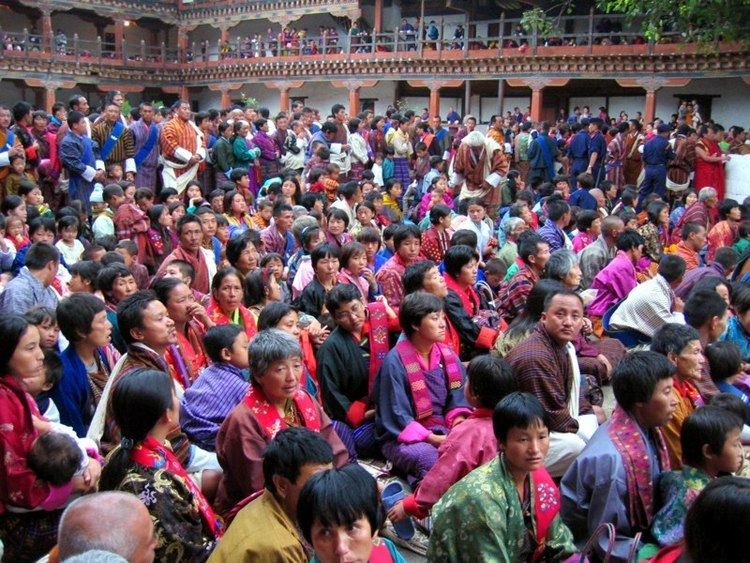 | ||
This article is about the demographic features of the population of Bhutan, including population density, ethnicity, education level, health of the populace, economic status, religious affiliations and other aspects of the population.
Contents
- Map of Bhutan
- Bhutans bimodal population estimates
- Demographic statistics
- Ethnic groups
- Religions
- Languages
- Literacy
- Population
- Life expectancy at birth
- Vital statistics
- Structure of the population
- HIVAIDS
- References
Map of Bhutan
Bhutan's bimodal population estimates
The Royal Government of Bhutan listed the country's population as 752,700 in 2003.
One explanation for this discrepancy is that the higher CIA numbers ultimately trace back to an inflated population number the Bhutanese government supplied to the United Nations in the early 1970s in order to gain entry into that body (the UN reportedly had a cutoff population of one million at that time). According to this theory the CIA population experts have retained this original inflated number year after year while adjusting it each year for normal population growth.
An alternative theory is that the western and central districts of the country wish to underestimate the populations of the southern and eastern districts in order to maintain their historical dominance over those districts. This is the claim made by some Bhutanese refugee groups. Certainly the government numbers do not include people, that were living in the refugee camps in Nepal and other persons forced out of Bhutan, which total approximately 125,000, majority of whom have now resettled in the USA.
The Bhutanese numbers can be reconstructed from their 9th Five Year Plan documents, which lists the exact number of households in each gewog. If the Bhutanese refugee advocate groups are correct, a spot check of a southern gewog should show a massive under-reporting of population.
The CIA World Fact book number has since been adjusted with a note of former inconstencies, and attributes the difference to the government not including the "first modern census of Bhutan, conducted in 2005". It should also be noted that in the 1970s Bhutan was one of the most isolated countries in the world and nobody knew how many people lived there since no census had ever been taken.
Demographic statistics
The following demographic statistics are from the CIA World Factbook, unless otherwise indicated.
Ethnic groups
Ngalop (also known as Bhote) 50%Lhotsampas (also known as Nepali language speaker 35%Indigenous or migrant tribes 15%Religions
Lama Buddhism 75.3%Hinduism 22.1%Other 2.6%Languages
Tshangla (sometimes referred as as Sharchopkha) 28%Dzongkha (official) 24%Nepali (locally referred as Lhotshamkha) 22%Other 26%Literacy
Definition: age 15 and over can read and writeTotal population: 47%Male: 60%Female: 34% (2003 est.)Population
708,427 (July 2011 est.)716,896 (July 2012 est.)Age structure
0-14 years: 28.9% (male 104,622/female 100,383)15-64 years: 65.3% (male 245,054/female 217,864)65 years and over: 5.7% (male 21,347/female 19,157) (2011 est.)Median age
Total: 24.8 yearsMale: 25.4 yearsFemale: 24.2 years (2011 est.)Population growth rate
1.201% (2011 est.)Birth rate
18.75 births/1,000 population (2012 est.)Death rate
6.99 deaths/1,000 population (July 2012 est.)Net migration rate
0 migrant(s)/1,000 population (2012 est.)Total fertility rate
2.13 children born/woman (2012 est.)Urbanization
urban population: 35% of total population (2010)rate of urbanization: 3.7% annual rate of change (2010-15 est.)Sex ratio
At birth: 1.05 male(s)/femaleUnder 15 years: 1.04 male(s)/female15-64 years: 1.13 male(s)/female65 years and over: 1.12 male(s)/femaleTotal population: 1.1 male(s)/female (2011 est.)Life expectancy at birth
Total population: 67.3 yearsMale: 66.46 yearsFemale: 68.19 years (2011 est.)Vital statistics
Below is a table of Bhutan vital statistics since 1950 published by the United Nations Department of Economic and Social Affairs.
Structure of the population
Structure of the population (01.07.2013) (Estimates) (Data refer to projected figures based on the Population and Housing Census 2005 (district projection)):
HIV/AIDS
In 2011, there were 246 reported cases of HIV in Bhutan, representing just over 0.3% of the population. In July 2010, there were a total of 217 cases detected, however Health Ministry sources indicated actual numbers were estimated at more than 500 by UNAIDS.
Through July 2010, there had been a total of 40 deaths due to HIV/AIDS-related causes, and one suicide.
